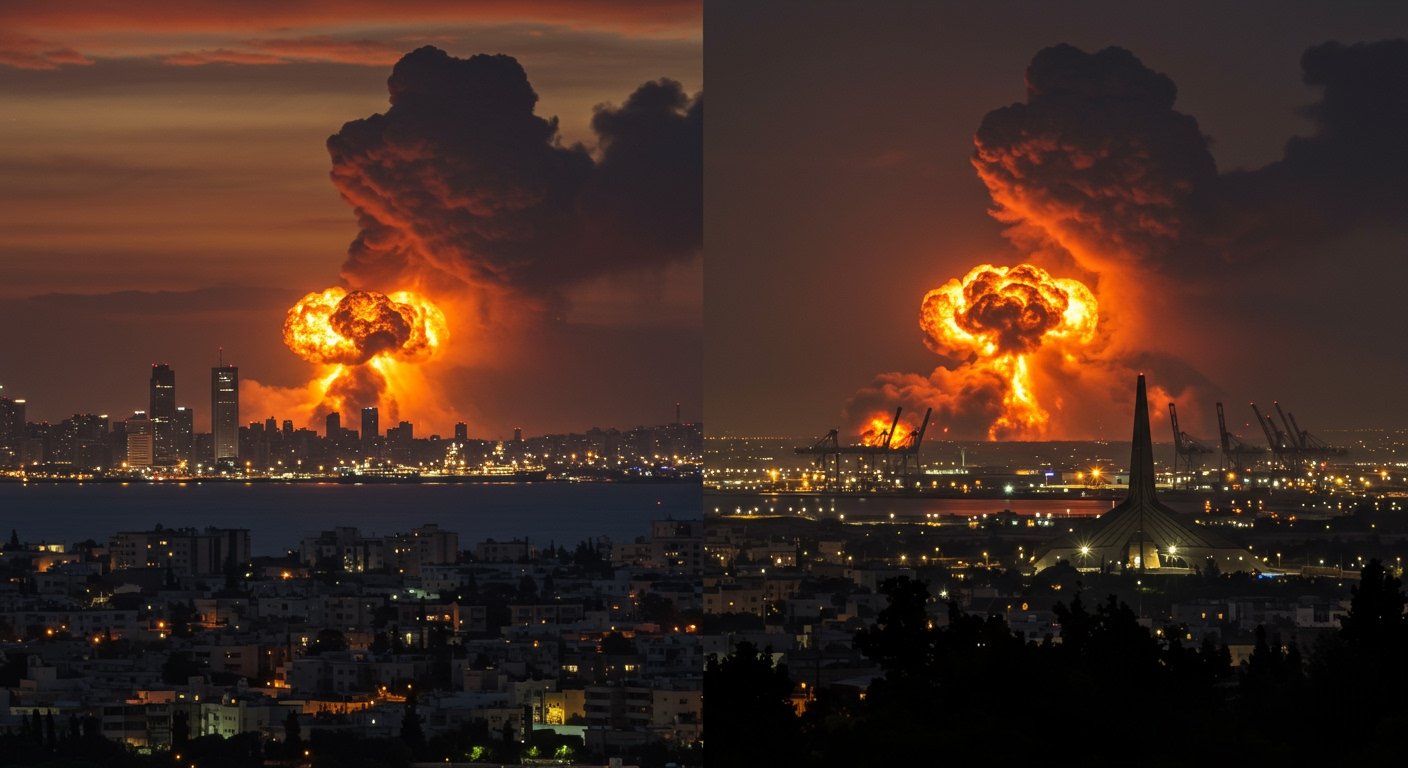Recent developments have plunged the Middle East into a deeper crisis, marked by direct military exchanges between Iran and Israel. On June 23, 2025, Iranian missiles were reportedly fired towards Israeli territory, coinciding with reports of massive explosions rocking the Iranian capital, Tehran. This dramatic escalation follows closely on the heels of significant United States military action against Iran.
Simultaneous Attacks and Repercussions
Reports from the region on June 23, 2025, indicated that Iranian missiles were directed towards Israel. While specific impact sites were initially unclear, there were concrete reports suggesting that at least one missile had struck the city of Ashdod, a major port city on Israel’s southern Mediterranean coast. The potential targeting of a populated Israeli urban center signals a dangerous phase in the long-standing shadow conflict between the two regional adversaries, bringing the confrontation out into the open. The extent of damage or casualties in Ashdod from this reported strike remained under assessment amid the rapidly unfolding situation.
Concurrently, multiple sources reported huge explosions occurring within Tehran itself on the same day, June 23, 2025. The nature, location, and cause of these explosions were not immediately confirmed, fueling speculation and adding another layer of complexity and uncertainty to the volatile situation. The simultaneity of reported Iranian strikes on Israel and major blasts in Tehran has led observers to connect the events, although official confirmations and explanations for the Tehran explosions were scarce in the immediate aftermath. The twin events underscored the intense and unpredictable nature of the current geopolitical climate in the Middle East.
Context: ‘Operation Midnight Hammer’
The direct exchange on June 23, 2025, unfolded less than 24 hours after the United States conducted significant airstrikes on Iranian territory. These U.S. strikes, reportedly part of an operation dubbed ‘Operation Midnight Hammer’, took place on June 22, 2025. The stated targets of the U.S. action were Iranian nuclear facilities, including the highly sensitive Fordow facility, which is known for its uranium enrichment activities deep underground.
Reports detailed that ‘Operation Midnight Hammer’ reportedly involved the deployment of B-2 bombers, known for their stealth capabilities, and utilized powerful 30,000-pound bombs. These munitions are designed to penetrate hardened targets, suggesting the U.S. aimed to severely degrade or destroy key components of Iran’s nuclear infrastructure. The operation reportedly targeted a total of three Iranian nuclear facilities on June 22, 2025. The U.S. stated its actions were aimed at preventing Iran from acquiring nuclear weapons capabilities, a long-standing concern for both Washington and its regional allies like Israel.
Following the U.S. strikes, Israeli Prime Minister Benjamin Netanyahu publicly thanked President Trump. This expression of gratitude highlighted the close strategic coordination and shared objectives between the two nations regarding Iran’s nuclear program and regional influence. Netanyahu’s statement underscored Israel’s support for decisive action against Iranian nuclear ambitions.
Iran, for its part, swiftly issued stern warnings following the U.S. action. Iranian officials vowed to respond and warned of serious consequences, interpreting the U.S. strikes as a direct act of aggression. These warnings set the stage for the subsequent events of June 23, 2025, raising fears that a cycle of retaliation was commencing.
International Reactions and Concerns
The rapid escalation has triggered alarm across the international community. The United Nations Security Council convened an emergency meeting to discuss the deteriorating situation. During the council meeting, several member states voiced deep concern over the potential for the conflict to widen beyond the current participants. Russia and China, permanent members of the Security Council, reportedly took a leading role in pushing for an immediate ceasefire and de-escalation of tensions. Their stance reflected a desire to prevent the conflict from spiraling out of control and potentially impacting global stability and energy markets.
Concerns about a wider escalation of the conflict are being raised internationally. Analysts and policymakers fear that direct military confrontation between major regional and global powers could have devastating consequences for the Middle East and beyond. The interplay between Iran, Israel, and the United States, combined with the involvement of proxies and the strategic interests of global players, creates a highly combustible environment where miscalculation could lead to a broader war.
India’s Evacuation and Airspace Clarification
Amidst the heightened military tensions and uncertainty, several nations have taken steps to ensure the safety of their citizens in the region. India, which maintains significant economic and cultural ties with countries across the Middle East, undertook evacuation efforts for its nationals residing in Iran. On June 22, 2025, the same day as the U.S. strikes, India successfully evacuated 311 Indian nationals from Mashhad, a major city in northeastern Iran. This evacuation brought the total number of Indian citizens repatriated from Iran since the onset of the current phase of tensions to 1,428.
Furthermore, in response to speculation, the Indian government officially debunked claims that the United States had used Indian airspace for conducting the strikes on Iran. This clarification was important to avoid any perception of India’s complicity in the U.S. military operation and to maintain its diplomatic position amidst the regional crisis.
The events of June 23, 2025, following the U.S. strikes on June 22, 2025, mark a critical turning point in the standoff between Iran and its adversaries. With missiles launched and explosions reported in key centers, and the international community grappling with the potential for wider conflict, the path forward remains fraught with danger and uncertainty for the Middle East and the world.





